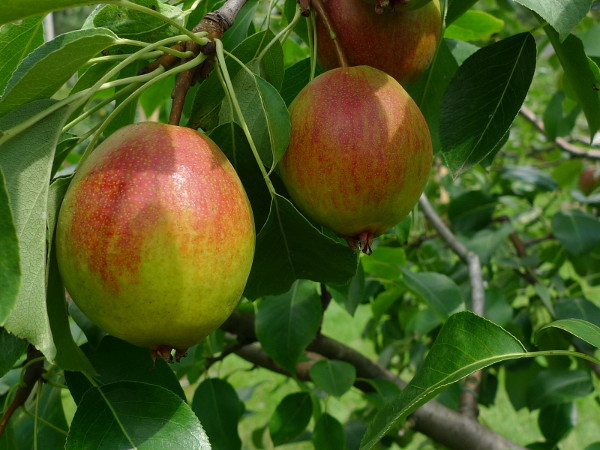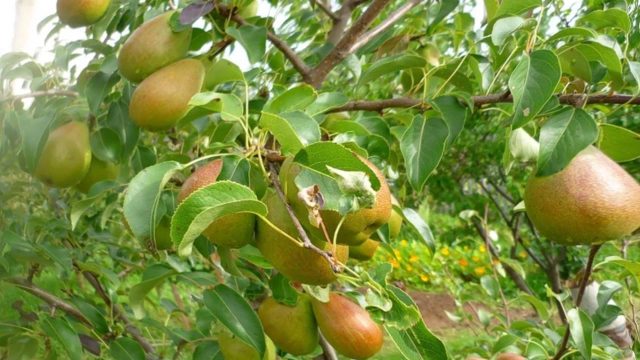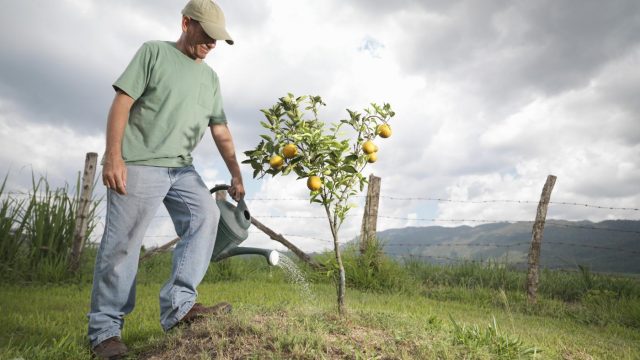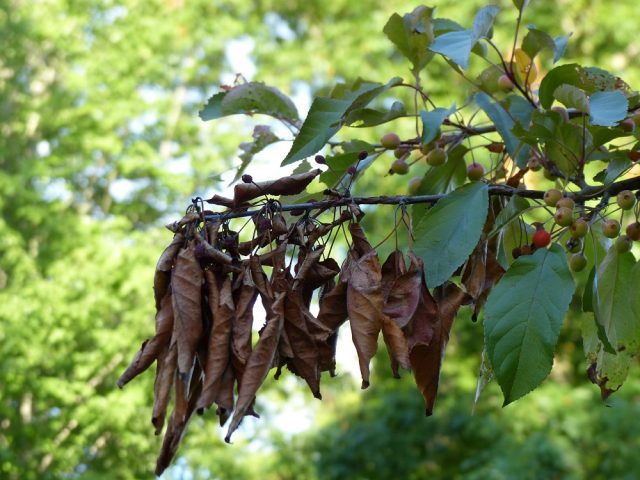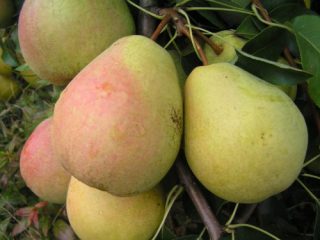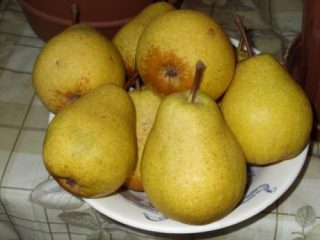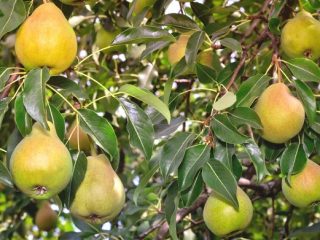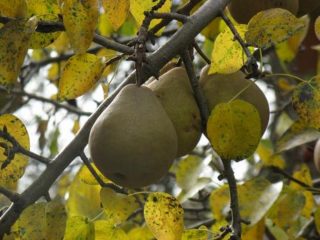Content
Description of pear Krasulia presents this variety as a type of very early ripening period. The parent varieties of the species are the Little Joy pear and the Late pear, and it got its name for the rich color of the fruits - as they ripen, they change color from a pale pink to a bright crimson hue. The Krasulia pear is zoned primarily for cultivation in the Urals, however, it bears fruit well in many other regions of central Russia. The key characteristic of the variety is the high cold resistance of the tree, which makes it possible to cultivate this variety in unfavorable climatic conditions.
Description of the pear variety Krasulia
Pears of the Krasulya variety belong to the category of medium-sized - the height of adult trees rarely exceeds the mark of 4 m. As the pear grows, it forms a spreading rounded crown. The branches of the tree grow almost parallel to the ground, slightly curving their ends up.
The trunk of the Krasulya variety has a slightly curved shape. The bark of the tree peels off.
The leaves of the variety are round, wide, with jagged edges. The leaf blade is not pubescent, in contrast to the shoots and petioles. Flower buds are large, elongated in shape. Fruiting of Krasulia pears is mixed - the tree forms fruits both on young shoots and on the branches of the previous year.
The flowers of the variety are large, white, resembling a bowl in their appearance. Blossoming of Krasulia pear is abundant. It starts in mid-May.
Fruit characteristics
The fruits of Krasulia pears are round in shape, but slightly flattened. Their weight varies from 85 g to 120 g. Funnels, typical for most varieties, are not observed in Krasulia pears. Instead, there is a small outgrowth on the fruit, by which this variety can be recognized.
Ripe Krasulia pear fruits have an attractive appearance, which formed the basis for the name of the variety. The peel of pears is smooth to the touch, glossy and very delicate.
The color of the fruits is light green with a yellow tint, however, over time, the pears become red and crimson. At the same time, tiny dark spots are noticeable on the skin.
The pulp of the fruit is tender, slightly loose. Reviews often emphasize the creamy texture of pears and the slight oiliness of the fruit. The taste is moderately sweet, without sugary notes.
Pros and cons of the Krasulya variety
In the reviews, gardeners note for the most part the following advantages of the Krasulia variety:
- attractive appearance of the fruit;
- early maturation;
- excellent taste;
- high winter hardiness;
- good immunity - the pear is resistant to diseases such as scab, fire blight and gall mite;
- high yield rates;
- high sugar content of fruits - when cooking and preserving, the amount of added sugar is significantly reduced.
Despite the rather extensive list of positive qualities of the Krasul pear, this variety is also not devoid of disadvantages, which include:
- relatively small fruit size;
- the sweet taste of the fruit may seem cloying to some people;
- the presence of thorns on the shoots;
- short shelf life of the harvested crop - the fruits must be sold or processed within 1-2 weeks.
Optimal growing conditions
When choosing a site for growing Krasulia pears, you should focus on sunny places, reliably protected from gusts of strong winds. It is also important to pay attention to the level of occurrence of groundwater in the selected area - they must be at least at a depth of 2 m from the earth's surface.
The composition of the soil does not really matter, however, on fertile loose soils, plantings, of course, develop better. A planting pit for a pear is dug 2 weeks before planting.
Planting and caring for Krasulia pear
Caring for the Krasulia pear variety provides for the standard procedures for the gardener:
- weeding;
- loosening the trunk circle;
- regular watering;
- timely pruning;
- whitewashing of the trunk and skeletal branches;
- preventive measures against pests and diseases;
- cleaning the trunk circle from debris and fallen leaves;
- shelter for the winter.
The Krasulia pear variety is planted in the spring, in April. In this case, you should wait until stable warm weather is established, since the last winter frosts can cause freezing of the roots of seedlings.
Landing rules
Pears of the Krasulia variety are planted both in spring and autumn. It is recommended to plant trees at a distance of 3-5 m from each other. The variety develops best in areas with loamy and sandy loam soil. The acidity of the soil should be moderate.
The optimal size of the planting pit is 70-90 cm in diameter and 1 m in depth.
The landing procedure looks like this:
- A nutritious soil mixture is placed at the bottom of the planting pit. It is made independently by mixing the earth dug out of a pit with humus (2 buckets), sand (1 bucket), potassium chloride (0.5 kg), ash (1 kg), superphosphate (0.5 kg) and dolomite flour (half a bucket) ... The resulting mixture is filled to 1/3 of the well.
- After 4-5 days, a small peg is driven in a little from the edge from the center - it should be at least 50 cm higher than the ground level.
- A mound of earth from the garden plot is poured into the center of the pit. On top of this mound, the roots of the seedling are laid out.
- The root system is covered with soil and lightly compacted without pressing the soil too hard. The root collar should be above ground level.
- The trunk of the seedling is tied to a peg.
- Along the edge of the trunk circle, at a distance of 30 cm from the plant, a small hole is pulled out for watering. 5 liters of water are poured into it.
- Complete the planting procedure by mulching the seedling. Peat or compost can be used as mulch.
Watering and feeding
The Krasulia variety is watered regularly, however, planting cannot be poured - stagnant water in the soil leads to rotting of the root system of trees. The recommended frequency of watering is 2-3 times a month, however, in many respects, one should be guided by the weather conditions. If it often rains in the growing region, then watering is reduced. During periods of abnormal heat and prolonged drought, plantings are watered more often.
An average of 3 buckets of water go under one tree.
They begin to feed the Krasulia variety at the 2nd year of life. After that, fertilizers are applied to the soil every 3-4 years. In spring, preference is given to nitrogen-containing organic fertilizers, however, at the end of summer and autumn, gardeners switch to feeding with phosphorus and potassium.
Pruning
In order to form the correct crown, the seedlings are cut immediately after planting. The growth of young shoots is stimulated by cutting the shoots to 1/3 of the total length.
In a pear, about 2 years old, the second largest shoot is shortened by 2/3. The remaining branches are cut by 1/3.
Trees older than 3 years are pruned solely for sanitary purposes. Shoots growing inside the crown are cut from pears, and broken and dried branches are also removed.
Whitewash
It is recommended to whitewash the trunk of the pear in November or December. This is done in order to provide the tree with protection from frost damage and sunburn in the spring, when the snow begins to melt.
Preparing for winter
Pear Krasulya is a winter-hardy variety that is not insulated in central Russia. This does not apply to young seedlings that are still too weak to survive cold temperatures. It is better to cover trees up to 2 years old for the winter, after sprinkling the trunk circle with mulch.
Protection from rodents will be provided by covering the trunk with spruce branches.
Pear pollinators Krasulia
Pear Krasulia does not belong to self-pollinated varieties. In order for the planting to bear fruit, other varieties of pears should be planted nearby for cross-pollination. The best candidates for this role are the Severyanka and Raduzhnaya pear varieties.
Yield
One of the leading features of the Krasulia variety is a consistently high yield. Fruiting of this species begins at the 5th year of life.
From 1 adult tree, from 35 kg to 50 kg of fruits are harvested. Pears ripen by the beginning of August.
Diseases and pests
Pear Krasulia is quite resistant to the activity of pests and rarely gets sick. This not only makes it easier to care for the garden crop, but also saves on chemical and natural treatments for fungus and other infections.
On the other hand, this does not mean that the Krasul pear is never infected with diseases. In particular, the variety is quite vulnerable to the following diseases:
- powdery mildew;
- fruit rot;
- rust.
The fact that the pears were struck by powdery mildew is evidenced by whitish spots on the leaves of trees. It is possible to minimize the risk of damage to plantings with powdery mildew through preventive measures in the spring months. The disease is prevented by timely treatment of the tree with a solution of colloidal sulfur every 2 weeks. Enough 2-3 sprays in the spring. In autumn, the variety is treated with Bordeaux liquid.
If the pear is still sick, the fight against powdery mildew is carried out using potent chemicals. For this, drugs are suitable:
- "Topaz";
- "Speed";
- "Vitaros";
- Previkur.
Fruit rot overtakes the plantings of Krasulia pears during a period of high humidity - in summer, when it rains too often. The first signs of the disease are the appearance of brownish spots on the pulp of the fruit.
Prevention of fruit rot involves treating trees with Bordeaux liquid and urea solution.
For pear rust, Krasul is sprayed with the following fungicides:
- "Strobe";
- "Hom";
- Medex;
- Azophos.
Treatments are carried out both before and after flowering.
Pests practically do not bother this variety, however, the most likely threats to plantings can be identified:
- leaf roll;
- pear honeydew;
- pear moth.
Any commercial insecticide will work to control these insects. Well proven:
- "Karbofos";
- Fitoverm;
- Iskra-M;
- Kinmix;
- "Decis".
There are also popular ways to protect plantings from pests:
- The larvae of leaf rollers are destroyed using infusion of tobacco and makhorka. To do this, 200 g of tobacco is mixed with 200 g of tobacco and 10 liters of water are poured. The resulting solution is kept for 2 days, filtered and diluted with another 5 liters of water. The infusion is used to spray pears.
- Adult pear coppers are discouraged by fumigation of trees with tobacco smoke.
- In spring, the pear moth is caught in special trapping belts, which are attached to tree trunks. Butterflies are caught using baits.
Reviews of gardeners about the Krasulia pear variety
Conclusion
Description of Krasulia pear attracts both professional farmers and amateur gardeners. This variety is especially appreciated in regions with unfavorable climatic conditions, since Krasulia is able to withstand rather low temperatures without harm to subsequent fruiting. The unpretentiousness and early maturity of this species also formed the basis of its popularity, although it was bred quite recently. Finally, the attractive appearance of the Krasulia pear fruit allows you to grow a variety for sale - the harvest is sold out quickly.
You can learn more about the features of the Krasulia pear variety from the video below:
